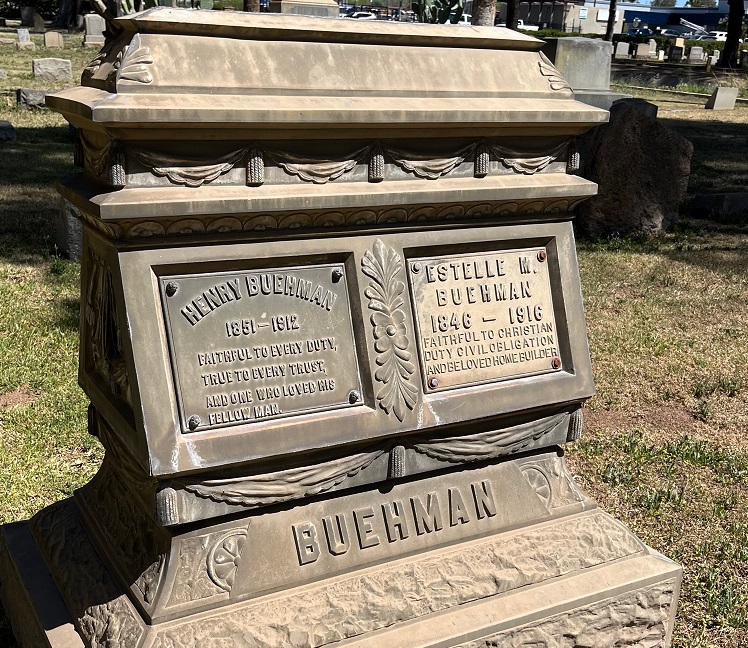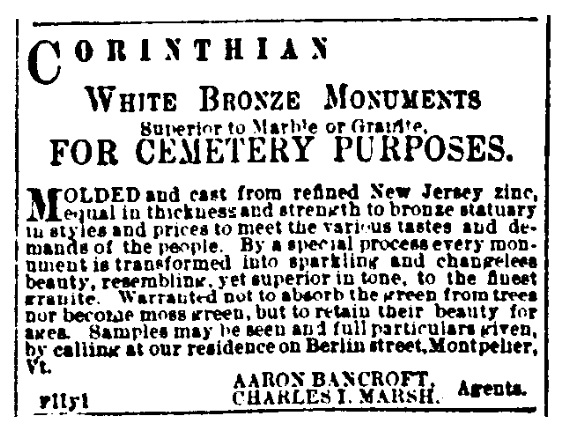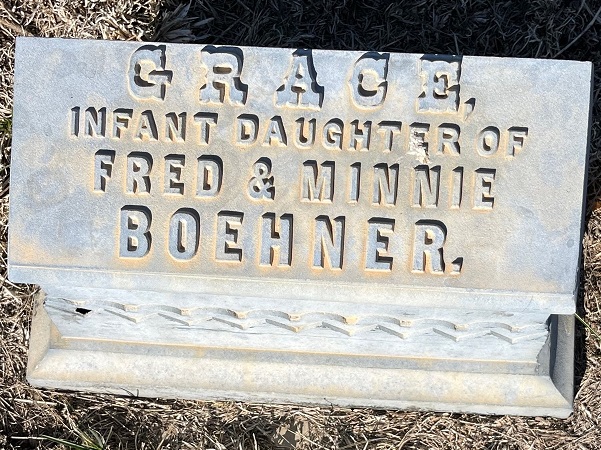Introduction: In this article, Gena Philibert-Ortega writes about an unusual grave marker you may find in your cemetery research: white bronze. Gena is a genealogist and author of the book “From the Family Kitchen.”
Genealogists love cemeteries. Whether it’s an ancestor’s burial or a unique marker, we love to explore and analyze the gravestones we find. While the majority of markers we encounter are made of some sort of stone, usually granite or marble, grave markers can be made of other materials including metal. One of the more unusual late 19th and early 20th century ones are white bronze markers.

White Bronze Markers
First, what is white bronze? The term “white bronze” is really a misnomer. White bronze is not really bronze, nor is it white. It is made of an alloy of copper, zinc, and tin (in grave markers it’s mostly zinc). Aside from monuments, it has also been used for jewelry. (1)

It’s perfect for outdoor applications because it does not tarnish, it is resistant to corrosion, and it’s largely nonporous. It wears better and is less expensive than marble markers.
In a collection of historical newspapers, such as GenealogyBank’s Historical Newspaper Archives, you can find testimonials to the durability of these markers.
Here is another testimonial.
However, even though it has many benefits when used in cemeteries, white bronze is not indestructible. (2) It can be dented, panels can be removed, and they can buckle.
Why the Name?
So why the name “white bronze?” It appears to be partially a marketing decision. An 1885 article in Scientific American explained that the name “white bronze” was adopted to distinguish it from the “dark or antique bronze, also from the cheap statues made of sheet metal.” (3) The article also reported:
The work is produced exclusively by the Monumental Bronze Company, Bridgeport, Conn., The Detroit Bronze Company, Detroit, Mich., The Western White Bronze Company, Des Moines, Ia., The American White Bronze Co., Chicago, Ill., and the St. Thomas White Bronze Monument Company, St. Thomas, Ont. (4)
When you see a white bronze marker in a cemetery, it may initially appear to be made of stone. Some people have described the color as having a blueish tint. One giveaway that the marker is not made of stone is the seam along the side of the marker (in some cases) and the metal feel and noise when you gently knock on it (they can be damaged so you need to be gentle). If you look at the back of the marker, you should see the name of the manufacturer and location listed toward the bottom.
Author Chris Haugh, in the “Stories in Stone” blog, writes about the genesis of white bronze markers:
“These standout funerary memorials were the brainchild of a man named Milo Amos Richardson (1820-1900) and business partner and brother-in-law, C. J. Willard. Mr. Richardson worked as a cemetery superintendent in Chautauqua County, New York, and had observed the need for a new and better material for cemetery monuments. He set out to develop a solution of creating a material for memorials that would repel moss, algae and lichen, invasive and unwelcome guests that take up residence on traditional gravestones, especially monuments in shady locations within cemeteries characterized by abundant tree cover or dampness.” (6)
An 1878 White Bronze Monuments catalog explained:
Though necessity is the mother of this invention, it is no less true that Milo A. Richardson is its lawful father, who for many years, having had charge of a cemetery where he carefully noted the disintegrating properties of stone – especially of marble, and that many granite monuments, though free from blemish when purchased, were soon badly stained by iron rust, a defect that cannot be detected until it is exposed to the weather; also, that moss and lichen were gradually but surely enveloping it, and obscuring the record – finally came to the conclusion that it was an imperative necessity that a more enduring, and if possible, a changeless material should be adopted, to perpetuate the memory of departed friends. (7)
The End of an Era
Markers that are resistant to damage seem like an obvious improvement over other markers. White bronze was not only used for grave markers, it was also used for other types of statuary – such as this example of a soldier’s monument.
Producing a marker that is more durable makes sense but not everyone embraced the idea of white bronze. Interestingly, Scientific American commented on this in the conclusion of their 1885 article on the industry by writing:
We are living in the age of telegraphs, telephones, electricity for lights and motive power, and many other useful improvements regularly chronicled in these pages, all of which have a value in their peculiar uses, and so with the subject of our sketch on [the] front page. (8)
The era of the white bronze marker ended with World War I because of the need for zinc for the war effort. White bronze markers were produced from 1874 to 1914 (panels added to existing markers may be found after 1914). Their presence in cemeteries is a reminder of the effort made to ensure that those who had departed would have a lasting monument to their lives.
Explore over 330 years of newspapers and historical records in GenealogyBank. Discover your family story! Start a 7-Day Free Trial
Note on the header image: white bronze graver marker, Arapahoe Cemetery, Nebraska. Credit: Gena Philibert-Ortega.
Related Articles:
- It’s Not All Online: Cemetery Research
- Genealogy Tips: Lessons Learned from Writing a Cemetery Book
- Genealogy Tip: What Does a Gravestone Tell Us?
- Genealogy Tip: What a Gravestone Tells Us – Grave Markers
- Genealogy Tip: How Accurate Is That Gravestone?
- Cemetery Language: A Glossary for Genealogists
_______________
(1) “White Bronze Grave Markers,” Stephen F. Austin State University (accessed 17 April 2023).
(2) Ibid.
(3) Scientific American, November 1885, pg. 309. Available from Internet Archive at https://archive.org/details/scientific-american-1885-11-14/page/n5/mode/2up.
(4) Ibid.
(5) “White Bronze Markers,” Stories in Stone (http://www.mountolivethistory.com/stories-in-stone-blog/white-bronze-markers: accessed 17 April 2023).
(6) White Bronze Monuments Statuary, &c. Paxson Comfort and Company. Available on Internet Archive https://archive.org/details/whitebronzemonum00paxs/mode/2up.
(7) Scientific American, November 1885, pg. 309. Available from Internet Archive at https://archive.org/details/scientific-american-1885-11-14/page/n5/mode/2up.
(8) “White Bronze Markers,” Stories in Stone (http://www.mountolivethistory.com/stories-in-stone-blog/white-bronze-markers: accessed 17 April 2023).
